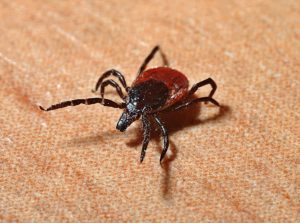For such tiny creatures, ticks can be real destructive forces of nature. Yet, the bite itself of a tick is quite harmless, and at worst, all you’ll feel is a tiny prick or itch, as a brown little bug attaches itself to your skin. A minor nuisance, to be sure.
But the danger part doesn’t come from the bite, it’s from what the bite has. Ticks are the perfect vectors for transmitting disease from one organism to another, and some of them can be quite dangerous or even deadly to humans.
While ticks are picky in what they choose to bite, this does not mean that they won’t latch on to the things that they don’t usually bite. For instance, ticks found on dogs obviously prefer sucking the blood of your canine friend, but it is not unheard of for them to bite humans as well.
Ticks start off as small and brownish in color. The longer they manage to stay attached to their animal of choice, the bigger and fatter they will get. Ticks that have sucked a lot of blood will change color, changing from brown to a pale greenish blue color.
And of course, there are many types of ticks all over the world, and you should always pay attention of your surroundings. You may not be in danger of being eaten by a bear, but you may find your blood slowly being drained, while disease ravages your body. Here are some notable ticks in particular:
Deer Tick/Black-legged Tick
The first up on our list is a common fellow. Deer ticks are found in wooded and grassy areas in the Northeast and Northern parts of the United States. If you’re around this area, it would probably be a good idea to stay away from tall grass.
Deer ticks are named for the fact that their most favored host is the white-tailed deer, but they have no qualms on feasting on human blood as well. They can be as small as a poppy seed, and still pack a nasty bite. Well, not a painful one, but certainly something you’ll notice later on.
Deer ticks are the most common cause of Lyme disease in people, cats, and dogs. If you find yourself bitten by a Deer tick, remove it as soon as possible to reduce your chances of contracting Lyme disease. If you’re uncertain if you’re infected, a common first symptom is a rash appearing in the shape of a bullseye in the location of the tick bite. Said rash does not itch, so you’ll need to be vigilante of the bite location. Otherwise, there are other symptoms you should pay attention to as well, such as chills, fevers, headaches, and swollen lymph nodes.
Thankfully, Lyme disease can often be cured, but don’t hesitate to seek medical help as soon as possible if you suspect that you may have been infected. Long-term infections can cause arthritis, stiffness, and even an irregular heartbeat.
Brown Dog Tick
Brown dog ticks are perhaps one of the most common (if not the most common) tick species, as they can be found all over the world. But they primarily prefer warmer environments.
These ticks are a nuisance, as they can hide in practically any spot inside or outside a house. They prefer being behind cover, of course, so as to not be spotted.
Now, these ticks aren’t as much of a problem to humans. In fact, they rarely actually bite people. Instead, as their name suggests, they latch on to dogs. This can be quite dangerous, as these ticks can carry serious parasites and diseases like ehrlichiosis, babesiosis, and bartonellosis. What a mouthful! But very dangerous indeed, as they can cause fever, depression, and even lameness.
Lone Star Tick
Do you like meat? Do you think that a life of no meat is no life at all? Do you think that a meal is incomplete if there isn’t some form of animal in it? Then pay attention to this one, because it’s going to be a doozy.
The Lone Star tick is aptly named for the white spot on the back of adult females, of which the shape resembles that of a star. Adult males, on the other hand, have white streaks or spots on their backs.
Their bites are actually quite painless, making them difficult to spot, as you are unlikely to notice them biting you unless you’re actually looking directly at them.
So, what makes them quite dangerous? Well, they can spread different types of diseases. Tularemia, for instance, is one of which the symptoms can include skin rashes, high fever, or even an ulcer. It can be treated with antibiotics but can be fatal if left to fester. Lone Star ticks have also been reported to have the ability to spread Heartland virus, wherein being infected has symptoms of headaches, fever, as well as low white blood cell and platelet count, which can be disastrous for one’s immune system. To make matters worse, as of this moment, there is no cure, only ways to alleviate the pain.
To bring back the mention of meat earlier, ticks can spread alpha-gal syndrome. This is a type of allergy that makes a person allergic to red meat. Some are mild, and some can be severe. The way this works is that a Lone Star tick that bites someone transports a sugar molecule called alpha-gal to a person’s body, potentially causing an immune system response, and as a result, making a person allergic to read meat. Like the Heartland virus, there is no cure. The only way you can alleviate the allergy is to avoid red meat altogether.

